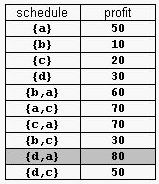POJ 1456 Supermarket
2012-08-06 09:45
204 查看
Supermarket
Description
A supermarket has a set Prod of products on sale. It earns a profit px for each product x∈Prod sold by a deadline dx that is measured as an integral number of time units starting from the moment the sale begins. Each product takes precisely one unit of time for being sold. A selling schedule is an ordered subset of products Sell ≤ Prod such that the selling of each product x∈Sell, according to the ordering of Sell, completes before the deadline dx or just when dx expires. The profit of the selling schedule is Profit(Sell)=Σx∈Sellpx. An optimal selling schedule is a schedule with a maximum profit.
For example, consider the products Prod={a,b,c,d} with
(pa,da)=(50,2), (pb,db)=(10,1), (pc,dc)=(20,2), and (pd,dd)=(30,1). The
possible selling schedules are listed in table 1. For instance, the
schedule Sell={d,a} shows that the selling of product d starts at time 0
and ends at time 1, while the selling of product a starts at time 1 and
ends at time 2. Each of these products is sold by its deadline. Sell is
the optimal schedule and its profit is 80.

Write a program that reads sets of products from an input text file
and computes the profit of an optimal selling schedule for each set of
products.
Input
A set
of products starts with an integer 0 <= n <= 10000, which is the
number of products in the set, and continues with n pairs pi di of
integers, 1 <= pi <= 10000 and 1 <= di <= 10000, that
designate the profit and the selling deadline of the i-th product. White
spaces can occur freely in input. Input data terminate with an end of
file and are guaranteed correct.
Output
For
each set of products, the program prints on the standard output the
profit of an optimal selling schedule for the set. Each result is
printed from the beginning of a separate line.
Sample Input
Sample Output
Hint
The sample input contains two product sets. The first set encodes the products from table 1. The second set is for 7 products. The profit of an optimal schedule for these products is 185.
Source
Southeastern Europe 2003
//开始以为只有一组测试数据呢
//贪心,然赚钱多的尽可能被卖掉
| Time Limit: 2000MS | Memory Limit: 65536K | |
| Total Submissions: 6961 | Accepted: 2903 |
A supermarket has a set Prod of products on sale. It earns a profit px for each product x∈Prod sold by a deadline dx that is measured as an integral number of time units starting from the moment the sale begins. Each product takes precisely one unit of time for being sold. A selling schedule is an ordered subset of products Sell ≤ Prod such that the selling of each product x∈Sell, according to the ordering of Sell, completes before the deadline dx or just when dx expires. The profit of the selling schedule is Profit(Sell)=Σx∈Sellpx. An optimal selling schedule is a schedule with a maximum profit.
For example, consider the products Prod={a,b,c,d} with
(pa,da)=(50,2), (pb,db)=(10,1), (pc,dc)=(20,2), and (pd,dd)=(30,1). The
possible selling schedules are listed in table 1. For instance, the
schedule Sell={d,a} shows that the selling of product d starts at time 0
and ends at time 1, while the selling of product a starts at time 1 and
ends at time 2. Each of these products is sold by its deadline. Sell is
the optimal schedule and its profit is 80.

Write a program that reads sets of products from an input text file
and computes the profit of an optimal selling schedule for each set of
products.
Input
A set
of products starts with an integer 0 <= n <= 10000, which is the
number of products in the set, and continues with n pairs pi di of
integers, 1 <= pi <= 10000 and 1 <= di <= 10000, that
designate the profit and the selling deadline of the i-th product. White
spaces can occur freely in input. Input data terminate with an end of
file and are guaranteed correct.
Output
For
each set of products, the program prints on the standard output the
profit of an optimal selling schedule for the set. Each result is
printed from the beginning of a separate line.
Sample Input
4 50 2 10 1 20 2 30 1 7 20 1 2 1 10 3 100 2 8 2 5 20 50 10
Sample Output
80 185
Hint
The sample input contains two product sets. The first set encodes the products from table 1. The second set is for 7 products. The profit of an optimal schedule for these products is 185.
Source
Southeastern Europe 2003
//开始以为只有一组测试数据呢
//贪心,然赚钱多的尽可能被卖掉
#include <iostream>
#include <stdio.h>
#include <string.h>
#include <algorithm>
#include <queue>
#include <cmath>
#define N 10002
using namespace std;
struct node
{
int val,last;
bool operator<(const node&a)const
{
return val>a.val;
}
};
node gy
;
bool h
;
int main()
{
int n,sum;
int i,k;
while(scanf("%d",&n)!=EOF)
{
sum=0;
memset(h,0,sizeof(h));
for(i=0;i<n;i++)
scanf("%d%d",&gy[i].val,&gy[i].last);
sort(gy,gy+n);
for(i=0;i<n;i++)
for(k=gy[i].last;k>0;k--)
if(!h[k])
{
sum+=gy[i].val;
h[k]=1;
break;
}
printf("%d\n",sum);
}
return 0;
}
相关文章推荐
- poj 1456 Supermarket(并查集维护区间)
- poj 1456 Supermarket
- POJ 1456 SuperMarket
- poj1456 - Supermarket
- G - Supermarket POJ - 1456
- 【POJ】1456 - Supermarket(并查集,好题)
- POJ 1456 Supermarket [贪心+并查集]
- POJ 1456 Supermarket 区间问题并查集||贪心
- poj 动态规划DP - 1456 Supermarket
- POJ 1456 Supermarket(贪心+并查集优化)
- POJ 1456 - Supermarket
- poj 1456 Supermarket
- POJ 1456 Supermarket(贪心)
- POJ 1456 Supermarket
- POJ 1456 Supermarket(贪心+并查集)
- poj 1456 Supermarket 贪心,我已开始用dp,没做出来,惭愧!!
- POJ 1456 Supermarket
- POJ-1456-Supermarket
- POJ 1456 Supermarket(贪心)
- poj 1456 - Supermarket(贪心+并查集)
